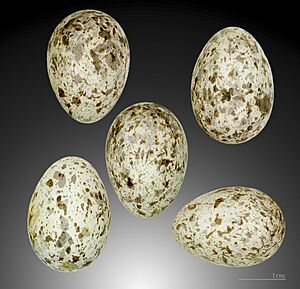Rock sparrow facts for kids
Quick facts for kids Rock sparrow |
|
|---|---|
 |
|
| In Ariege, Midi-Pyrenee, France | |
| Conservation status | |
| Scientific classification | |
| Synonyms | |
|
The rock sparrow or rock petronia (Petronia petronia) is a small passerine bird. It belongs to the sparrow family, called Passeridae. This bird is special because it's the only one in its group, the Petronia genus. Rock sparrows live in rocky hills. You can find them from Spain and North Africa, across southern Europe, and all the way to Siberia and China. Birds in the western parts of their range usually stay put. However, those in Asia often migrate to warmer places or move down from mountains when it gets cold.
Contents
About the Rock Sparrow
The rock sparrow is about 14 centimeters (5.5 inches) long. It looks a lot like a house sparrow but has a bigger, cone-shaped beak. It has a clear whitish stripe above its eye and a lighter stripe on its head. Its back and wings are patterned brown. Its belly has streaks, and it has a yellow spot on its throat. This yellow spot is a key feature, but it can be hard to see.
Both male and female rock sparrows look similar. They both have a bright yellow patch on their upper chest. This patch stands out against their earthy brown feathers. The yellow color comes from something called carotenoid. This yellow patch is very important during the breeding season. It shows how attractive a bird is and its social standing in the group. Rock sparrows also have a loud, wheezy song.
Where Rock Sparrows Live
Rock sparrows live in barren, rocky areas. They are also found in towns and villages in suitable places. They are very social birds.
Sometimes, a rock sparrow might fly far away from its usual home. This is called being a "vagrant." For example, one rock sparrow was seen in Cley, Norfolk, Great Britain, on June 14, 1981. This was the only time one had been recorded there!
Reproduction and Life Cycle
Rock sparrows build their nests in cracks in rocks or walls. They usually lay four to five eggs. These birds have different ways of finding a mate. Some pairs stay together (monogamy). Others might have one female mate with several males (polyandry). However, most rock sparrows are socially monogamous, meaning they mostly stick to one partner.
Many studies show that both male and female rock sparrows prefer a mate with a larger yellow patch. This yellow patch seems to signal a good mate. Males with more colorful mates tend to protect their nests more. They also put more effort into caring for their young if the female has a brighter yellow patch. Females, however, don't change their care based on the male's yellow patch.
In some areas, like the Alps, female rock sparrows do most of the feeding for their young. But in Asian groups, both males and females share the job of feeding their chicks equally. Larger male rock sparrows tend to feed their young more often. This might mean they have better territories or are better fathers. Studies also show that chicks of males with bigger yellow patches grow longer legs. This suggests that these males are better parents. As the breeding season goes on, females visit their nests more often without food. This might be because they have fewer chances to lay more eggs, so they focus on helping their current chicks survive.
Food and Feeding
Rock sparrows mostly look for food on the ground. They eat seeds all year round. In the autumn, they also enjoy berries. In the spring, their diet changes to include insects, especially caterpillars and grasshoppers. They also feed these insects to their young chicks.



